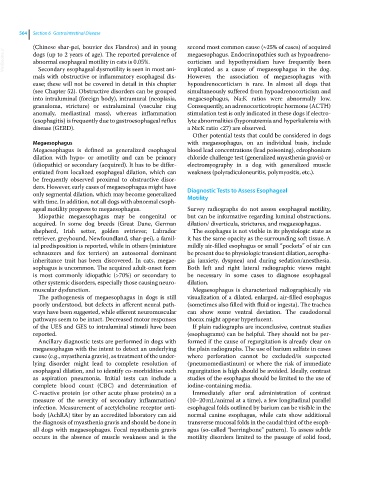Page 596 - Clinical Small Animal Internal Medicine
P. 596
564 Section 6 Gastrointestinal Disease
(Chinese shar‐pei, bouvier des Flandres) and in young second most common cause (≈25% of cases) of acquired
VetBooks.ir dogs (up to 2 years of age). The reported prevalence of megaesophagus. Endocrinopathies such as hypoadreno-
corticism and hypothyroidism have frequently been
abnormal esophageal motility in cats is 0.05%.
Secondary esophageal dysmotility is seen in most ani-
However, the association of megaesophagus with
mals with obstructive or inflammatory esophageal dis- implicated as a cause of megaesophagus in the dog.
ease; these will not be covered in detail in this chapter hypoadrenocorticism is rare. In almost all dogs that
(see Chapter 52). Obstructive disorders can be grouped simultaneously suffered from hypoadrenocorticism and
into intraluminal (foreign body), intramural (neoplasia, megaesophagus, Na:K ratios were abnormally low.
granuloma, stricture) or extraluminal (vascular ring Consequently, an adrenocorticotropic hormone (ACTH)
anomaly, mediastinal mass), whereas inflammation stimulation test is only indicated in these dogs if electro-
(esophagitis) is frequently due to gastroesophageal reflux lyte abnormalities (hyponatremia and hyperkalemia with
disease (GERD). a Na:K ratio <27) are observed.
Other potential tests that could be considered in dogs
Megaesophagus with megaesophagus, on an individual basis, include
Megaesophagus is defined as generalized esophageal blood lead concentrations (lead poisoning), edrophonium
dilation with hypo‐ or amotility and can be primary chloride challenge test (generalized myasthenia gravis) or
(idiopathic) or secondary (acquired). It has to be differ- electromyography in a dog with generalized muscle
entiated from localized esophageal dilation, which can weakness (polyradiculoneuritis, polymyositis, etc.).
be frequently observed proximal to obstructive disor-
ders. However, early cases of megaesophagus might have Diagnostic Tests to Assess Esophageal
only segmental dilation, which may become generalized Motility
with time. In addition, not all dogs with abnormal esoph-
ageal motility progress to megaesophagus. Survey radiographs do not assess esophageal motility,
Idiopathic megaesophagus may be congenital or but can be informative regarding luminal obstructions,
acquired. In some dog breeds (Great Dane, German dilation/ diverticula, strictures, and megaesophagus.
shepherd, Irish setter, golden retriever, Labrador The esophagus is not visible in its physiologic state as
retriever, greyhound, Newfoundland, shar‐pei), a famil- it has the same opacity as the surrounding soft tissue. A
ial predisposition is reported, while in others (miniature mildly air‐filled esophagus or small “pockets” of air can
schnauzers and fox terriers) an autosomal dominant be present due to physiologic transient dilation, aeropha-
inheritance trait has been discovered. In cats, megae- gia (anxiety, dyspnea) and during sedation/anesthesia.
sophagus is uncommon. The acquired adult‐onset form Both left and right lateral radiographic views might
is most commonly idiopathic (>70%) or secondary to be necessary in some cases to diagnose esophageal
other systemic disorders, especially those causing neuro- dilation.
muscular dysfunction. Megaesophagus is characterized radiographically via
The pathogenesis of megaesophagus in dogs is still visualization of a dilated, enlarged, air‐filled esophagus
poorly understood, but defects in afferent neural path- (sometimes also filled with fluid or ingesta). The trachea
ways have been suggested, while efferent neuromuscular can show some ventral deviation. The caudodorsal
pathways seem to be intact. Decreased motor responses thorax might appear hyperlucent.
of the UES and GES to intraluminal stimuli have been If plain radiographs are inconclusive, contrast studies
reported. (esophagrams) can be helpful. They should not be per-
Ancillary diagnostic tests are performed in dogs with formed if the cause of regurgitation is already clear on
megaesophagus with the intent to detect an underlying the plain radiographs. The use of barium sulfate in cases
cause (e.g., myasthenia gravis), as treatment of the under- where perforation cannot be excluded/is suspected
lying disorder might lead to complete resolution of (pneumomediastinum) or where the risk of immediate
esophageal dilation, and to identify co‐morbidities such regurgitation is high should be avoided. Ideally, contrast
as aspiration pneumonia. Initial tests can include a studies of the esophagus should be limited to the use of
complete blood count (CBC) and determination of iodine‐containing media.
C‐reactive protein (or other acute phase proteins) as a Immediately after oral administration of contrast
measure of the severity of secondary inflammation/ (10–20 mL/animal at a time), a few longitudinal parallel
infection. Measurement of acetylcholine receptor anti- esophageal folds outlined by barium can be visible in the
body (AchRA) titer by an accredited laboratory can aid normal canine esophagus, while cats show additional
the diagnosis of myasthenia gravis and should be done in transverse mucosal folds in the caudal third of the esoph-
all dogs with megaesophagus. Focal myasthenia gravis agus (so‐called “herringbone” pattern). To assess subtle
occurs in the absence of muscle weakness and is the motility disorders limited to the passage of solid food,

